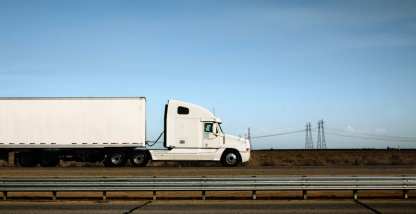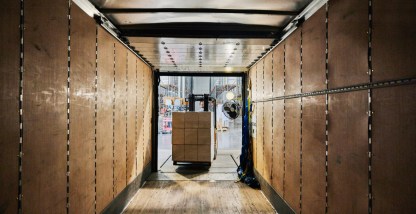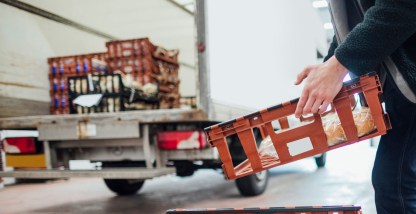A common business mantra is to always look forward. Yet, when it comes to supply chain sustainability, companies are now taking a closer look at reverse logistics. This often-overlooked part of the product lifecycle is getting more attention in response to market and customer expectations. Understanding this can add a competitive edge for commercial fleets.
What does reverse logistics mean?
To understand reverse logistics, we should start with forward logistics. Think of a manufacturer taking raw materials, fabricating parts, assembling the product, adding it to inventory, then selling that item to a customer, and finally delivering it to them. That’s all going to take logistics moving from the point of origin to the point of consumption—that process is called “forward logistics”.
Reverse logistics goes the other way. The flow is from the point of consumption back to the point of origin. The opposite of last-mile delivery, it extends part or product lifecycle by finding ways to return goods, reuse parts, recycle packaging materials, or responsibly dispose of expired products. Any of this recycling, refurbishing, or re-manufacturing is done to recapture value. There’s also a benefit to the environment as the raw materials used at the outset are reclaimed for further use or at least saved from adding to landfill waste.
What is the process of reverse logistics
Any process extending product lifecycle past the delivery to the end consumer involves reverse logistics. First coined in 1992, the term “reverse logistics” reflects growing attention to maximizing the product lifecycle and thinking always of environmental impact.
The boom in ecommerce also prompted greater attention to reverse logistics. Consumers are not only buying more online, but they are also expecting to be able to easily return what they don’t want. Look at Amazon—Statista estimates Amazon’s reverse logistics market share at 13%. Retailers need to offer attractive return policies today to meet customer expectations and drive sales. The challenge is finding an efficient and cost-effective way of reversing the logistics from the destination point.
Even when the customer doesn’t initiate a return of a recently purchased item, vendors and manufacturers can look for ways to encourage returns of valuable product elements or reuse of packaging. If you’ve ever traded in your old phone to purchase a new one, the process of sending back that old device for your purchase credit is part of reverse logistics.
Reverse logistics has many facets. For example, reusable packaging requires reverse logistic processes. The company must not only deliver the reusable bottles for milk, soda, or beer, but it must also have a system in place to retrieve those bottles for reuse to create a closed-loop system.
Reverse logistics examples
Imagine the potential value created by any of these examples:
- Customers returning goods
- Unsold inventory getting returned to partners
- Packaging reuse
- Refurbishing goods or products past their prime
- Providing repairs or maintenance to keep products in top shape
- Re-manufacturing returned, defective, or otherwise faulty goods
- Selling overstock or returned items on secondary markets
- Recycling and disposing of end-of-life goods
How reverse logistics can create value
According to Statista, “In 2020, the global reverse logistics market was valued at 635.6 billion U.S. dollars. By 2028, the reverse logistics market size is expected to exceed 958 billion U.S. dollars.” There are many ways in which reverse logistics creates value for different interests.
Offering reverse logistics support for product buyers or to downstream supply chain members can act as an incentive for sales. It also can help with customer retention and support a good brand image. However, creating value from this approach requires careful attention to inventory volumes and accounting for returns labor (e.g., processing, technical support) and shipping and storage costs.
For manufacturers, reverse logistics can also bring overall cost savings. Say you send back a smartphone when you upgrade to a new device. The company gets access to parts of that device that are costly to replicate or difficult to access due to supply chain difficulties. They might return parts to suppliers, refurbish the device for resale, or re-manufacture the device. Additionally, tracking the reasons for returns and identifying product trends can provide valuable insights for developing future products, choosing supply chain vendors, and anticipating customer behavior.
For vendors, finding a secondary market outlet for overstocked or returned goods helps them gain more revenue from their initial investment outlay.
Third-party logistics (3PL) providers and commercial fleets benefit from the reverse logistics market as they’re the ones paid to move the stock, whether the flow is forward to point of destination or back to point of origin.
Who’s responsible for reverse logistics management?
Generally, the company that originated the product is responsible for management. However, they may choose to outsource the processes to a trusted 3PL or commercial fleet.
The company will have to review, revise, and optimize its return policies and vendor agreements. But, once the cargo has reached its point of destination and reverse logistics is needed, the company can offload that responsibility to a company focused on this area of expertise. This saves the manufacturer or supplier from having to develop its own infrastructure. Instead, it can hire a provider who has invested in the necessary assets to get the job done efficiently. They may have centralized return centers, reverse logistics software or automation technology.
What are the advantages of reverse logistics?
Reverse logistics offers many advantages. While it may not be immediately intuitive, it can decrease costs. Recycling, reselling, or refurbishing items that would otherwise be a total loss can cut total cost of ownership. Reverse logistic processes can also help the overall system run more efficiently. If a manufacturer can repurpose items, profit margins can benefit.
When the business handles reverse logistics for customers, offering refunds and providing return shipping, customer experience improves. This can build brand loyalty and encourage people to buy more from that business in the future.
These processes also reduce waste. For instance, take fresh food delivered to its destination yet not purchased. If that food is not repurposed before it spoils, it could become part of the 30 percent of food in U.S. grocery stores that gets thrown away. Having a reverse logistics process in place can avoid that outcome.
Eliminating waste can also lower environmental impact. Along with providing incentives for recycling packaging or promoting returns instead of letting things end up in the landfill, those in charge of reverse logistics look to centralize return locations, establish local repair centers, and optimize shipping to avoid unnecessary transportation costs.
What are the disadvantages of reverse logistics?
Coordinating reverse logistics is not simple. Multiple parties can be involved in the coordination of an item going back from the consumer to a distribution center and then on to the next stage. Businesses need to have processes in place to verify, inspect, and test products. They may also need to repair and repackage the items, which requires labor and quality assurance.
Manufacturers need to track a lot of information along the way in reverse logistics. They may need to keep customers up-to-date on the status of returns, work with commercial fleets to get the items from point A to point B, handle restocking, or partner with companies that can recycle, refurbish, or resell the items. Preventing revenue loss also requires close accounting for costs throughout the process.
At the same time, customer demand for more convenient reverse logistics processes continues to grow. This puts added pressure on businesses to make returns fast and inexpensive, or for manufacturers to get repairs done quickly. Meanwhile, customers lack any real knowledge of what’s involved in meeting the rising demand.
What to look for in reverse logistics software
Reverse logistics is just one area of the supply chain, but technology providers have recognized the challenges and opportunities. It is possible today to find software that helps automate some of the many processes involved. Look for software with the following features.
Real-time tracking is essential. Throughout the reverse logistics process, many parties will want to know where that item is located. Customers want to track the progress of their return. Recipients want to plan for return arrival or anticipate the actions they will take to reduce losses. Having a software that provides regular communication with customers and tracks transportation improves refund, credit, or product exchange coordination.
Look for a reverse logistics software that helps analyze costs to evaluate best options and better understand bottom line impact. Associated costs could include:
- Transportation expenses (to deliver items, to send them back, and in case of exchange, to redeliver)
- Repair costs
- Labor payments for processing returns, quality testing, restocking, etc.
- Holding costs in case of restocking
A software that supports effective returns management can help decision makers determine the most cost-effective approach to take.
Any automation of processes can also help expedite the progress of goods. With support for streamlining workflows, the entire process can be enhanced for improved customer satisfaction and faster value creation.
Your ability to generate custom reports could also be a consideration. The software you invest in should help you to collect and analyze your reverse logistics data. This can help you with customer service, inventory adjustment, quality control, and more.
How to improve reverse logistics with Motive
Commercial carriers providing reverse logistics can improve their services offered with Motive’s fleet management software solution. Our comprehensive platform helps businesses tackle forward logistics, all the way to last-mile delivery, as well as reverse flow.
Motive’s AI-powered software solution empowers fleet managers to track assets and keep customers informed of cargo progress. GPS tracking coupled with route optimization tools can also expedite the returns process, which helps exceed customer expectations while giving the recipient more time to try to resell that item before spoilage.
Motive’s route optimization tools also help find the shortest and most cost-efficient routes. This can improve sustainability by lowering carbon emissions impact. Or use workflow dispatch to communicate changed routes to drivers that account for weather or accidents on the road.
Integrating our software with a driver’s electronic logging device (ELD) can also streamline processes. Our AI Dashcam further helps to minimize accidents and liability risks. Improve driver’s in-traffic behaviors with complete visibility into unsafe driving events and real-time alerts warning drivers of unsafe behaviors.
Motive’s technology supports the flow of logistics, whichever direction you’re going. Find out more today.










